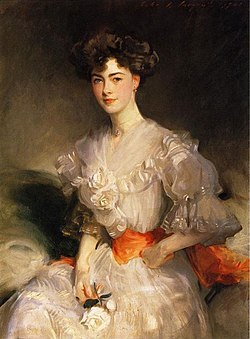Greta von Heidenstam: Difference between revisions
No edit summary |
No edit summary |
||
| (One intermediate revision by the same user not shown) | |||
| Line 1: | Line 1: | ||
[[Category:Leo von Heidenstam]] | {{Region icon Kylaris}} [[Category:Leo von Heidenstam]] [[Category:Geatish people]] [[Category:Geatland]] | ||
{{Infobox person | {{Infobox person | ||
| honorific_prefix = {{wp|Her Excellency}} | | honorific_prefix = {{wp|Her Excellency}} | ||
| Line 27: | Line 27: | ||
In Geatland, Greta moved around the country with her husband, who was often performing military duties. Greta began to learn {{wp|Swedish language|Geatish}}, though by her own admission she never mastered the language. During this time she bore four additional children: three sons and one daughter. The combination of Heidenstam's frequent absences and pregnancy left Greta with long bouts of {{wp|postpartum depression}}. She coped by writing in her {{wp|diary}} as well as by maintaining frequent correspondence with her husband. When [[King Rudolf's War]] broke out and her husband made to serve, Greta hit a particular low point and returned to Weisstadt to be with her mother. | In Geatland, Greta moved around the country with her husband, who was often performing military duties. Greta began to learn {{wp|Swedish language|Geatish}}, though by her own admission she never mastered the language. During this time she bore four additional children: three sons and one daughter. The combination of Heidenstam's frequent absences and pregnancy left Greta with long bouts of {{wp|postpartum depression}}. She coped by writing in her {{wp|diary}} as well as by maintaining frequent correspondence with her husband. When [[King Rudolf's War]] broke out and her husband made to serve, Greta hit a particular low point and returned to Weisstadt to be with her mother. | ||
After King Rudolf's War ended, Greta returned to Geatland to be with her husband, who had been promoted to {{wp|field marshal}}. Greta supported Heidenstam when he campaigned against republican revolutionaries in the [[Engström Revolt]]. After Heidenstam's success in crushing the revolt, he was tapped to be the first premier of a democratic Geatland in 1867. During [[Premiership of Leo von Heidenstam|Heidenstam's premiership]], Greta kept a mostly low profile. She formed a friendship with Queen Marguerite, the wife of [[Monarchy of Geatland|King]] [[Gunnar III of Geatland|Gunnar III]]. | After King Rudolf's War ended, Greta returned to Geatland to be with her husband, who had been promoted to {{wp|field marshal}}. Greta supported Heidenstam when he campaigned against republican revolutionaries in the [[Engström Revolt]]. After Heidenstam's success in crushing the revolt, he was tapped to be the first premier of a democratic Geatland in 1867. During [[Premiership of Leo von Heidenstam|Heidenstam's premiership]], Greta kept a mostly low profile. She formed a friendship with Queen Marguerite, the wife of [[Monarchy of Geatland|King]] [[Gunnar III of Geatland|Gunnar III]]. When Heidenstam finished his term in 1878, Greta returned with him to [[Kungslandning]]. | ||
When Heidenstam died in 1882, Greta was thrown into a deep depression. She took up smoking and developed an eating disorder. She died in 1887 and was buried alongside her husband. | |||
==Personality and legacy== | ==Personality and legacy== | ||
Latest revision as of 15:50, 21 August 2020
The Duchess of Dromund | |
|---|---|
 Greta in her wedding dress, 1924 | |
| Born | Greta Mulborg 14 September 1802 |
| Died | July 5, 1887 (aged 84) Kungslandning, Ibsäm, Geatland |
| Nationality | Cislanian (later Weranian) Geatish |
| Known for | Wife of Leo von Heidenstam |
Greta von Heidenstam, Duchess of Dromund (born Greta Mulborg; 14 September 1802 – July 5 1887) was a Geatish-Weranian noblewoman and diarist. She was the wife of Leo von Heidenstam, the first premier of the Geatish Realm.
Biography
Greta von Heidenstam was born to a prominent Amendist family in Weisstadt, Cislania. Greta studied at a private grammar school and spent much of her childhood with her maternal uncle Rudolf Hesse. In April 1823, Greta met Leo von Heidenstam, then a Geatish military officer with Cislanian ancestry. Greta and Heidenstam formed a close relationship, and Heidenstam courted her. Although Greta was originally intended to marry another man, her family accepted Heidenstam to be her husband. The couple married in July 1824. Greta bore her fist child, Karl, in 1826 returned to live permanently in Geatland after the Weranian Revolution of 1828.
In Geatland, Greta moved around the country with her husband, who was often performing military duties. Greta began to learn Geatish, though by her own admission she never mastered the language. During this time she bore four additional children: three sons and one daughter. The combination of Heidenstam's frequent absences and pregnancy left Greta with long bouts of postpartum depression. She coped by writing in her diary as well as by maintaining frequent correspondence with her husband. When King Rudolf's War broke out and her husband made to serve, Greta hit a particular low point and returned to Weisstadt to be with her mother.
After King Rudolf's War ended, Greta returned to Geatland to be with her husband, who had been promoted to field marshal. Greta supported Heidenstam when he campaigned against republican revolutionaries in the Engström Revolt. After Heidenstam's success in crushing the revolt, he was tapped to be the first premier of a democratic Geatland in 1867. During Heidenstam's premiership, Greta kept a mostly low profile. She formed a friendship with Queen Marguerite, the wife of King Gunnar III. When Heidenstam finished his term in 1878, Greta returned with him to Kungslandning.
When Heidenstam died in 1882, Greta was thrown into a deep depression. She took up smoking and developed an eating disorder. She died in 1887 and was buried alongside her husband.